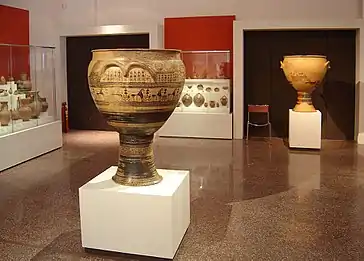Dipylon krater
Dipylon kraters are Geometric Period Greek terracotta funerary vases found at the Dipylon cemetery, near the Dipylon Gate, in Kerameikos, the ancient potters quarter on the northwest side of the ancient city of Athens. A krater is a large Ancient Greek painted vase used to mix wine and water, but the large kraters at the Dipylon cemetery served as grave markers.[1]

Vases representative of this larger "Dipylon Style," [2] are housed in the National Archaeological Museum, Athens[3] and the Metropolitan Museum of Art in New York.[4]
Description of the Dipylon krater in New York
The Met's Dipylon krater is 43 inches (110 cm) tall and has a circumference of 25.5 inches (65 cm).[4] The monumental vase is hollow, with a hole at the bottom, indicating that it was not used as a mixing bowl like regular kraters.[1] At the Dipylon Cemetery, where it was found, kraters marked the graves of men.[5] Decorations occupy the entire vase, separated into registers containing abstract motifs or figural designs in a dark-on-light style.
A key-patterned meander fills the top registers, while funerary iconography sits below. The figural scenes describe two of the three parts of a proper burial: a prothesis and an ekphora.[6] A prothesis is the laying out of a body for mourning, and an ekphora is the transportation of the body to the grave. The third step in a burial would be the actual burial of the body or its ashes.[6]
The prothesis scene on the Met's Dipylon Krater features standing women with triangular torsos surrounding a prostrate body underneath a checkered burial shroud.[1] The women raise their arms to their head, tearing out their hair as a sign of mourning for the deceased.[5] Abstract geometric motifs and animals fill space in between the figures in a dense style characteristic of the Late Geometric Period.[1] Underneath, the ekphora scene displays warriors with chariots and hourglass-shaped shields transporting the body in a funeral procession.[2]
The horses overlap each other without clear distinctions, in a stiff profile featured across the vase. The elaborate procession, complete with soldiers and horses indicates the importance this family placed on a proper burial,[7] a value also featured in canonical Greek texts like the Iliad.[6] The similarity of this vase's iconography to that of the Dipylon Amphora, attributed to the same artist, reveals that the rituals displayed were not isolated but were part of a larger tradition of Greek funerary rites in Geometric Period Athens.[7]
Sources
- Kleiner, Fred S. (2013-01-01). Gardner's Art through the Ages: The Western Perspective. Cengage Learning. ISBN 978-1133954811.
- Neer, Richard (2012). Greek Art and Archaeology. New York: Thames & Hudson. p. 76. ISBN 9780500288771.
- Α 00990, Attic geometric krater. From Dipylon, Kerameikos. By Hirschfeld Painter. 750-735 B.C.
- "Attributed to the Hirschfeld Workshop | Terracotta krater | Greek, Attic | Geometric | The Met". The Metropolitan Museum of Art, i.e. The Met Museum. Retrieved 2017-10-07.
- "Dipylon vases". www.brown.edu. Retrieved 2017-10-28.
- Art, Author: Department of Greek and Roman. "Death, Burial, and the Afterlife in Ancient Greece | Essay | Heilbrunn Timeline of Art History | The Metropolitan Museum of Art". The Met’s Heilbrunn Timeline of Art History. Retrieved 2017-10-28.
- MOORE, MARY B. (2007). "Athens 803 and the Ekphora". Antike Kunst. 50: 9–23. JSTOR 41321236.





